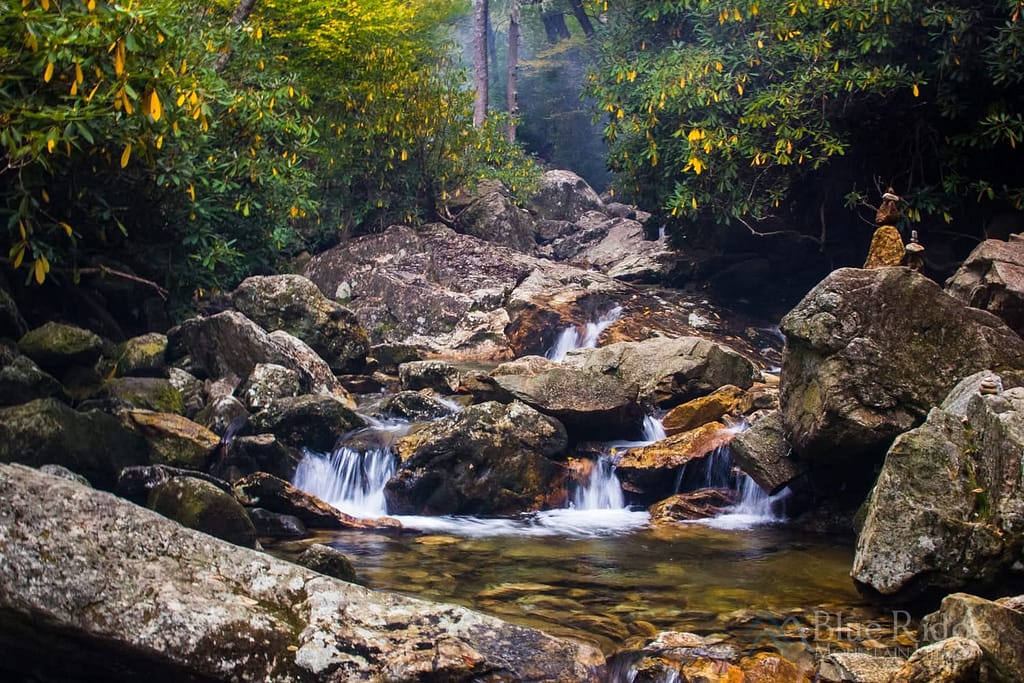Discover the Dragon Tree at Blue Ridge Parkway MP 417. Learn the history of this legendary birch, explore the scenic Graveyard Fields waterfalls, and find the best nearby attractions in Pisgah National Forest.

Nestled in the misty, high-elevation forests of the Blue Ridge Mountains in Western North Carolina, the Dragon Tree stands as one of the most beloved and intriguing natural landmarks along the scenic Blue Ridge Parkway. It is not just a tree, but a striking, living sculpture that has captured the imagination of hikers, photographers, and nature lovers for decades. Its dramatically twisted form—resembling a serpentine head and neck—makes it a pilgrimage site for those seeking the magical and mythical in the Appalachian landscape.

📜 History and The Tale of Its Shape
The Dragon Tree is a species of Yellow Birch, known for its flexible wood when young, which is key to its remarkable shape. While it’s relatively easy to find, the story of how it acquired its iconic form is shrouded in mystery and divided into two main theories:
1. The Natural Phenomenon Theory (The Scientific View)
Most natural resource experts and botanists conclude that the Dragon Tree’s shape is the result of a natural accident. The theory suggests that when the tree was a very young sapling, a much larger tree or heavy limb fell on it. This massive weight forced the young birch’s main trunk to bend sharply toward the ground. Instead of dying, the tree, driven by phototropism (the tendency to grow toward sunlight), redirected its growth. The original tip either died or was truncated, and a new, vertical branch grew upwards from the highest point of the sharp curve, eventually forming the “dragon’s head” seen today. The gnarled texture and thick bark along the curve are evidence of the severe injury it overcame.
2. The Native American Trail Marker Theory (The Legend)
The Dragon Tree is often misidentified as an authentic Cherokee Trail Marker Tree. According to this traditional belief, Native Americans intentionally bent and secured saplings to create living signposts, marking critical trail intersections, water sources, or important hunting grounds.
While the Dragon Tree is situated directly at an intersection of a modern trail (the Mountains-to-Sea Trail) and leads toward a historically significant area (Skinny Dip Falls), most modern experts agree the tree is not old enough to predate colonial times. The surrounding area is relatively new growth forest. However, the powerful imagery of a bent tree guiding travelers through the wilderness ensures this legend remains a cherished part of its history.

📍 Finding the Dragon: Directions and Location
The tree’s accessibility makes it a very popular stop, though it often gets overlooked by travelers focused on the grand vistas of the parkway.
- Location: Blue Ridge Parkway, Milepost (MP) 417, Western North Carolina.
- Parking: Park at the Looking Glass Rock Overlook.
- Trail Access: The trail to the Dragon Tree and Skinny Dip Falls begins across the road from the overlook parking area. Look for the Mountains-to-Sea Trail (MST) marker.
- The Dragon’s Lair: The tree itself is located only a few hundred feet (a very short walk) down the trail, right at the point where the path begins its descent toward the river.
🏞️ The Dragon’s Surroundings and Current Situation
The Dragon Tree resides in a cool, damp environment typical of the Pisgah National Forest.
- The Habitat: It is rooted in a lush, mixed hardwood and evergreen forest. The area is dense with rhododendrons and mountain laurel, whose twisted branches often frame the Dragon Tree and are particularly beautiful when in bloom during late spring. The ground is typically carpeted with moss, ferns, and deep leaf litter, contributing to the misty, old-world atmosphere captured in many photographs.
- The Current Status: Due to its immense popularity, the area immediately surrounding the tree suffers from significant foot traffic and soil compaction. This damages the tree’s root system and the delicate surrounding flora. While the tree itself remains a striking spectacle, park officials continually ask visitors to stay on designated paths and practice Leave No Trace principles to minimize erosion and protect the area. The tree is a sturdy survivor, but its famous location is constantly monitored to ensure its longevity.
The Dragon Tree is standing and accessible via the Blue Ridge Parkway at MP 417. However, the experience of the surrounding forest and the nearby water features has been significantly and permanently altered by Hurricane Helene.
As of the most recent updates, the section of the Blue Ridge Parkway that includes Milepost 417 (up to MP 420) has been restored and reopened following emergency repairs and tree clearing. This means access to the Looking Glass Rock Overlook and the Dragon Tree is currently possible, but travelers should always check the official National Park Service (NPS) Road Status map before driving, as work is ongoing.

🌊 Nearby Attractions for the Adventurer
The Dragon Tree serves as the gateway to some of the Blue Ridge’s most rewarding destinations:
- Looking Glass Rock: The sheer, imposing granite dome of Looking Glass Rock dominates the view from the overlook across the parkway. Its name comes from the way the exposed rock face can sometimes freeze over in winter, reflecting the sunlight like a mirror.
- Skinny Dip Falls (Milepost 417 Trailhead): The Dragon Tree marks the beginning of the trail down to what was once a pristine series of waterfalls and a swimming hole. Note: Skinny Dip Falls was catastrophically damaged by Tropical Storm Fred in 2021 and the most recent hurricane Helene in 2024. While the path remains, the beloved cascading falls and pools were largely washed away, altering the landscape significantly.
Current Situation: While new steps have been constructed to reach the creek level, the site is dramatically altered. The area is officially considered unstable and hazardous, and visitors are urged to use extreme caution. - Graveyard Fields (Milepost 418.8): Located just a short drive south on the Parkway, this popular area is named for the sight of tree stumps resembling grave markers after a huge windstorm and fire decades ago. It features high-elevation meadows, two major waterfalls (Lower and Upper Falls), and abundant blueberry bushes in the summer.
Like the Dragon Tree area, Graveyard Fields experienced both wind damage (treefall) and water damage (erosion), but the main waterfalls (Second Falls and Upper Falls) fared better than Skinny Dip Falls. - Current Situation: The Graveyard Fields Overlook and trails are generally open, but the landscape now features more evidence of the storm, including exposed roots, new clearings, and potentially muddier or more rutted trail sections due to high traffic and past saturation.
- Devil’s Courthouse (Milepost 422.4): A dramatic, jagged peak with a short, strenuous hike to an incredible 360-degree panoramic view of the mountains.
The Dragon Tree truly is a legendary spot—a natural curiosity that perfectly blends the geological history of the Appalachian Mountains with the enduring magic of local folklore.

Sources:
https://Blueridgemountainlife.com
National Park Service (NPS) websites related to the Blue Ridge Parkway (BRP).
Regional travel and hiking guides for Western North Carolina and the Pisgah National Forest.
Specific trail guides for Mileposts 417 (Looking Glass Rock Overlook) and 418.8 (Graveyard Fields).
Regional news sources and non-profit organizations focused on environmental recovery in Western North Carolina.
Official press releases and recovery project updates from the National Park Service (NPS) concerning the Blue Ridge Parkway damage.
Reports from the National Weather Service (NWS) and NOAA regarding the 2024 Atlantic Hurricane Season and the impact of Hurricane Helene on the Southern Appalachian region.
